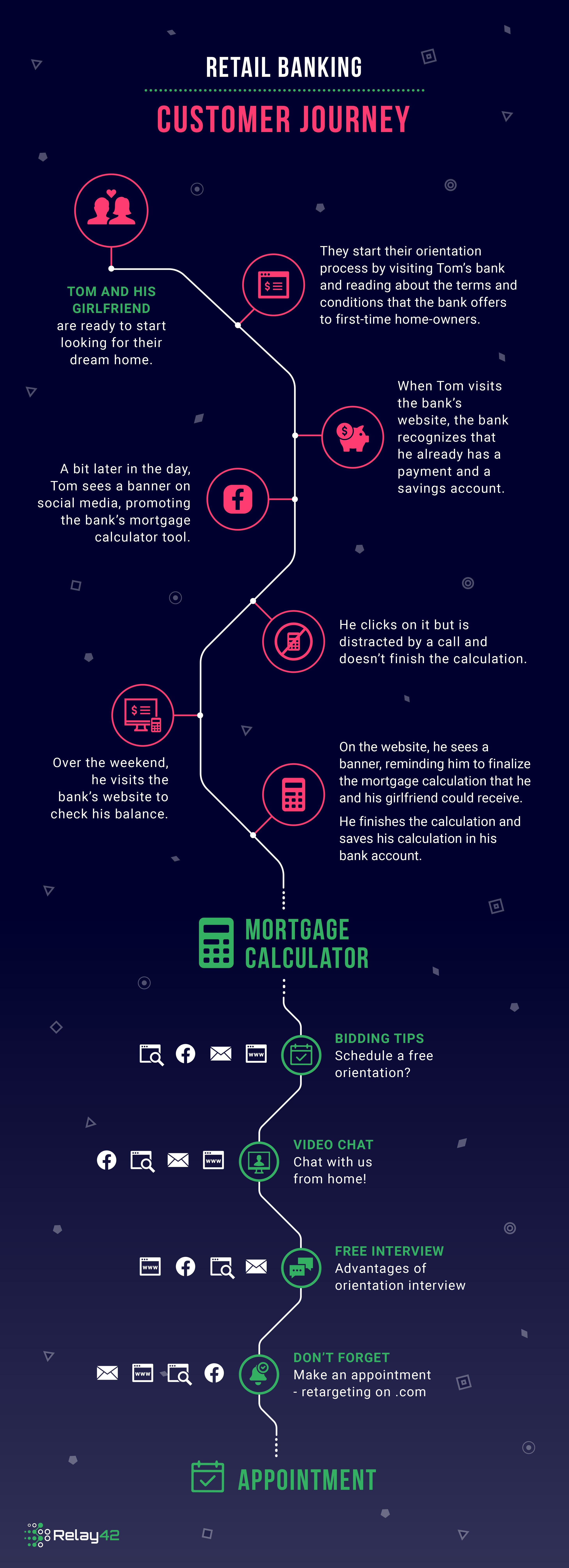Customer Data Platform Case Study
3 CDP case studies that generate real value for retail banks

9%
Increase in leads for mortgage appointments via search
>40%
Decrease in cost per lead
>4%
Increase in leads for mortgage appointments via website
Three CDP Use Case for Financial Services
For more than a decade, retail banks around the world have been on a journey towards digitalization, seeking new ways to retain existing customers and gain new ones. Facing increasing competition from tech-savvy fintech disruptors as well as the evolving consumer behavior, traditional retail banks were already under serious pressure to evolve.
The COVID-19 pandemic only accelerated the ongoing digital transformation processes, forcing banks to close their physical branches overnight and to shift both their marketing and customer services to digital channels. According to a World Retail Banking Report 2021, “the post-COVID-19 era will be defined by fierce competition, pushing banks to review priorities and realign investments in growth areas to meet higher customer expectations.” According to the study, banks can secure growth by adopting a data-driven approach and leverage their first-party data to hyper-personalize the customer experience.
The need for highly-regulated financial firms to invest in collecting and organizing their customer data has never been more paramount to ensure they can not only continue to provide stellar customer experiences but also maintain the acquisition of new customers in a compliant way. Across many millions of customers, the need to map out their digital journeys to understand and maintain consent for digital advertising is a difficult process, but also impossible without good first-party data.
To help marketers in financial organizations on their journey towards data-driven marketing, we’re sharing three successful case studies, created by one of our retail bank customers.
Hyper-personalizing the customer experience
Improving digital self-service customer experience and reducing call-center volumes
Driving qualified leads at a lower cost
Ambition: Personalized customer journeys
This multinational bank’s mission is to empower customers at all times — from the moment they open an account, through their entire customer lifecycle.
Similar to many traditional retail banks, the customer was working with a large marketing stack and was dealing with legacy systems. For the marketing team, this meant that they had to find an effective way to synchronize all marketing channels (owned, paid media), and connect the internal customer systems.
They reached out to Relay42 with the goal to overcome these technical challenges and help the marketing team create personalized, data-driven customer journeys across channels.
Case study 1 - Hyper-personalizing the customer experience
Goal
Improve the customer experience on the bank’s website by personalizing the content, based on the characteristics and preferences of each individual visitor.
Target audience
Existing and new customers who are exploring specific products and services on the bank’s website.
Tactics
The first step was to connect the bank’s website and CRM system to the Relay42 Platform. Through a combination of on-site behavior data and CRM data, the marketing team defined four audiences and mapped their customer journeys.
For instance, if a visitor is looking into getting a mortgage, the bank would recognize whether this visitor is an existing customer or a prospect and whether they already have a mortgage with the bank. Based on these insights, the website would recommend the next relevant information for this particular visitor.
Results
By personalizing the on-site customer experience, the marketing team was able to increase the CTR of the recommended content by more than 10%.

Case study 2 - Improving digital self-service customer experience and reducing call-center volumes
Goal
Help website visitors find the information they need on the bank’s website quickly and efficiently while reducing the calls towards the customer service center.
Target audience
Existing and new customers who are exploring the bank’s contact page and are about to get in touch with the call center.
Tactics
The marketing team started by exploring the most popular topics that call center agents were asked about. Based on this information, the team created a list of the most popular topics and marched this list to the relevant information pages on the website. If there were gaps in the available content on the website, the marketing team would create articles on these topics.
Next, the team started capturing the search behavior on the website and mapped it so that they would understand the steps that website visitors take before reaching out to the call center.
On the contact page, the team created a dynamic field that was filled with relevant information for each visitor, based on their latest search interaction and website behavior. This information was shown just before the website visitors would navigate to the phone numbers page, encouraging the website visitor to click on the call-to-action shown in the dynamic field.
Results
By personalizing the website based on visitor’s search behavior, the bank was able to reduce the clicks to the phone number page by 8% and reduce calls to the customer service agents by 5%.

Case study 3 - Driving qualified leads at a lower cost
Goal
The main goal of the case study was to increase the relevancy of the mortgage products while decreasing the online cost per lead (CPL).
Target audience
Existing and new customers who have shown interest in a mortgage product or are identified by the bank as potential homebuyers based on CRM characteristics.
Tactics
The marketing team looked at the whole customer journey of a potential homebuyer from the initial interest in a mortgage until a person books an appointment with a bank’s mortgage advisor.
Using data from the CRM, the marketing team identified characteristics of a first-time homebuyer (e.g. age, marital status). Within the Relay42 platform, the team defined the rules that would indicate a visitor’s interest in a mortgage.
Then, the marketing team created a two-step customer journey approach: 1) one to drive leads to their online mortgage calculator tool, and 2) to encourage appointments with one of the bank’s mortgage advisors.
The journey begins when a customer either meets the predefined CRM-based criteria or if they indicate interest on the website. When a person enters the journey, the Relay42 platform personalizes parts of the website and triggers a sequence of personalized banner ads, matching the profile of the customer. The goal is to encourage the visitors to calculate their potential mortgage using the bank’s free online calculator tool.
As a second step, the marketing team created a journey for the people who had already calculated their potential mortgage. The marketing team would use the information they gathered from the online calculator and merge it with what they already knew about these customers to target their communications through several highly personalized streams.
Then they could tweak the homepage messaging (and push communications) in real time, depending on whether prospects were looking to buy together or alone, or if it was their first or second home. In their communication, the marketing team would offer relevant tips for homebuyers and invite them to have a video orientation call.

Results
Intelligent Journey Orchestration enabled the marketing team to automatically include (or exclude) customer profiles from retargeting in real time, based on the phase of their customer journey.
As a result, the team was able to decrease the cost per lead by more than 40%, increase the leads via search by 9%, and increase the leads for mortgage appointments via the website by more than 4%.

Bonus result
The customer journey is always on and runs automatically, which allows the marketing team to focus on their strategy and developing new customer journeys.
Driving Marketing Growth Value for Inspiring Brands

+115% Conversion Rate Uplift on Brand Search
Levi's Strauss & Co.

+25% In revenue via email marketing
KLM Royal Dutch Airlines
.png?width=750&height=500&name=Untitled%20design%20(28).png)
+272.75% Increase in the number of vacancy alerts
Randstad
.png?width=750&height=500&name=Untitled%20design%20(25).png)
+86% Increase in leads
Vattenfall
.png?width=750&height=500&name=Untitled%20design%20(27).png)
+90% Increase in requests for information
Mazda Netherlands
See Relay42 in Action
Experience a first-hand tour of the Relay42 Customer Data Platform with one of our consultants

